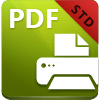 PDF-XChange Standard V9
PDF-XChange Standard V9
PDF-XChange Standard is a virtual printer that is used to convert industry-standard file formats to PDF. It's compatible with files from almost all Windows applications such as MS Word, Excel and AutoCAD. It features an optimized, hybrid engine that significantly increases the quality of conversion for images and image-based text characters, and prints to both GDI and XPS. PDF-XChange Standard installs as a virtual printer that generates fully-compatible, industry-standard, native PDF files. It is used in the same manner as a standard printer - simply open files in their native application, select the option to Print and then select PDF-XChange Standard from the list of available printers. The document will then be converted into PDF. You can also right-click web pages and click 'Convert to PDF' to convert web pages to PDF. There is a wide range of customizable settings available that can be used to enhance and edit converted documents, as detailed in the later chapters of this manual.
PDF-XChange Standard requires no additional 'plug-ins' or software. However, we recommend installing another of our products, PDF-XChange Editor, for the viewing and manipulation of files created using PDF-XChange Standard. It's completely free, and the two products are designed to work in tandem. The free version of PDF-XChange Editor is available at the download page of our website here.
We offer several other applications for the manipulation of PDF and image files. Please see the PDF-XChange Products Page for further information. The User Forums are an excellent resource for troubleshooting, and our Knowledgebase contains over four hundred articles about our software and other relevant information. If you have any queries then please Contact Us.
This manual is composed of the following sections:
•Installation details the installation process, system requirements, installation switch options and licensing details for the software.
•PDF-XChange Standard User Manual details the operations that the software performs and associated settings.
•The Features Overview details the main features of PDF-XChange Standard.
•The Printer Settings section details the customizable features and functionality of PDF-XChange Standard, and is structured to match the UI of the software.
•The PDF Saver section details the PDF Saver feature, which is used to determine some settings of PDF-XChange Standard, and to perform print jobs from the command line.
•The MS Office Toolbar Add-in section details the PDF-XChange Standard toolbar add-in for MS Office applications.
•The MS Outlook Add-in section details the MS Outlook Add-in, which is used to convert emails to PDF.
•The OFFice2PDF section details the OFFice2PDF feature, which enables the batch-conversion of MS Excel/Word and (*.html) documents to PDF.
•The Features Added in Version 9 section details all features added in version 9 of the software.
A PDF version of this manual is available here. The system administrator's guide, for managing PDF-XChange products across an enterprise, is available here.
The PDF Format
The Portable Document Format (PDF) is an internationally-recognized file format that was developed in 1992 in order to present documents, including text formatting and images, between users of different platforms, application software, hardware and operating systems, who may not have access to mutually-compatible application software. PDF files are based on the PostScript page-description language, and every PDF file contains a complete description of a fixed-layout flat document, including the text, fonts, vector graphics, raster images and other information required to display it. PDF was standardized as an open format in 2008, and since then has expanded to contain a range of additional content besides flat text and graphics, including logical structuring elements, interactive elements such as annotations and form fields, layers, rich media (including video content), three dimensional objects that use the U3D or PRC formats, encryption options, digital signatures, file attachments and document metadata. The specifications of the PDF format are defined and maintained by the International Organization for Standardization (ISO), which determines the content that is permitted in PDF documents, the properties of that content and the manner in which it can be manipulated. The original PDF specification was created in 1993, and since then it has been regularly expanded and enhanced to include additional content. The ISO published the most recent specification, PDF 2.0, ISO 32000-2:2020, in December 2020. All documents that are created and/or edited with PDF-XChange software conform to the ISO specification and are therefore compatible with all systems and software worldwide that also conform to the ISO specification.